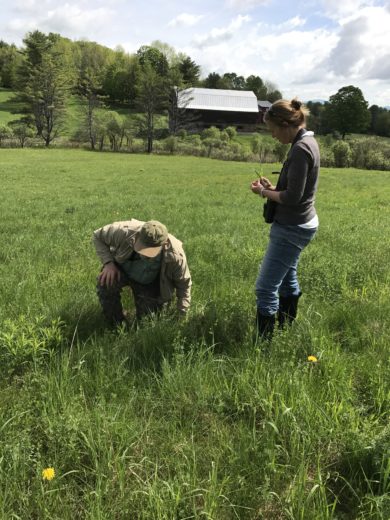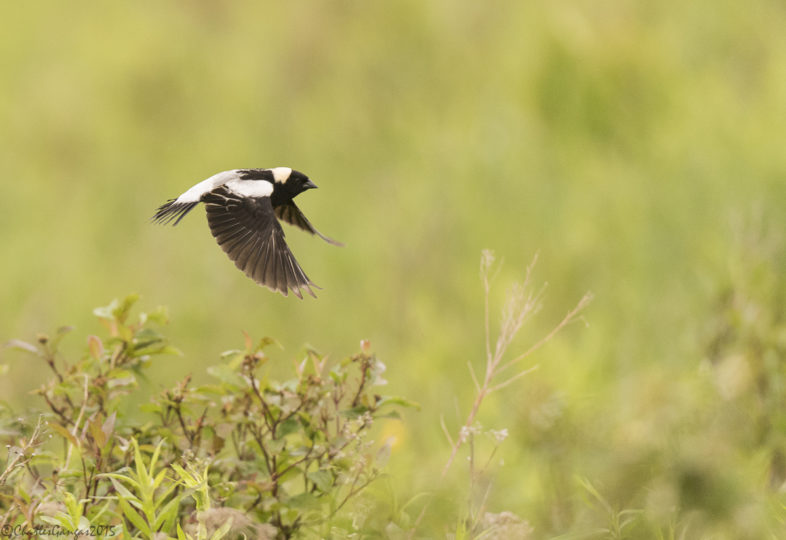In May, spring birdsong explodes with the arrival of hormone-drunk travelers keen on defending a territory and enticing a mate. One such traveler, the Bobolink, makes the longest trip of any migrant songbird in the Northeast. The Bobolinks’ aerial marathon begins in Argentina, courses through Colombia and the Caribbean, and finally ends in grasslands across the northern tier of the U.S. and southern Canada. These tenacious travelers need our help to ensure that their annual 12,000-mile round-trip trek is not in vain.
You may wonder, and with good reason, why in the forest-dominated Northeast we should be concerned with a bird species that depends on grasslands. It turns out that Bobolinks find our open meadows and hayfields just perfect for raising their families—but almost certain peril awaits.
A calendar of the Bobolink’s nest cycle shows that they need several, undisturbed weeks to nest and fledge their young. The birds’ needs pose a dilemma, however, for landowners who depend on high-protein hay required for feeding cattle, especially dairy producers. Farmers need to mow in June when the protein content of hay is highest, which unfortunately coincides with Bobolinks’ nesting season, and well before birds have raised any young.

Cathryn Abbott (Vermont Center for Ecostudies) and Jim Kennedy (Landscape Architect/Wetlands Scientist) assess vegetation structure on a farm in Vermont.
Agriculture remains an important part of our economic and cultural heritage in the Northeast. We value our farms and the expansive, unobstructed views of mountains and lakes made possible by open agricultural land. We can make the most of these lands by also providing habitat for grassland birds, whose populations have been declining for decades—even in the heart of their range in the Midwest, where open lands are abundant. In short, grassland birds need help wherever they can get it, and all indications suggest the Northeast will continue to harbor habitat they can use.
The possibilities for providing grassland bird nesting habitat vary from one piece of land to another, and depend on the constraints of the landowner. Financial incentives to offset the loss of income from delaying mowing until later in the summer are available to farmers who qualify. There are also other creative approaches, such as leaving the Bobolink-favored fields last for mowing.
There is no one-size-fits-all solution, but there are basic guidelines and resources at hand. For landowners and land managers needing customized assistance, VCE works one-on-one to explore options and link people with tools and incentives. Please contact us at to learn more.
The celebration of our international avian diplomats, International Migratory Bird Day, occurs on May 13th, near the peak of the Bobolink’s return. We can ensure they remain part of our landscape by giving them a place to call home.


Very glad to see this piece on the importance of New England hayfields to Bobolinks. As VCE has discovered, our own Meadow Brook Farm hayfields in Sedgwick, Maine, were purchased specifically to preserve nesting habitat for grassland birds and are under conservation easement to Blue Hill Heritage Trust. The easement prohibits mowing before July 15, but we are pleased that the fields actually are not mowed until late August after blueberry season. The mower takes the hay for barrens burning and sells the best for animal feed. There is a chapter in my just-released book “Sailor for the Wild — On Maine, Conservation and Boats” about Meadow Brook Farm, a brief section of which is devoted to Bobolinks, others of our birds, the fields, and the mowing. I recognize that active farmers must work to a different set of priorities and am glad that VCE offers customized assistance.